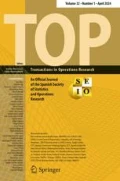Abstract
This paper surveys learning techniques to deal with the two most crucial decisions in the branch-and-bound algorithm for Mixed-Integer Linear Programming, namely variable and node selections. Because of the lack of deep mathematical understanding on those decisions, the classical and vast literature in the field is inherently based on computational studies and heuristic, often problem-specific, strategies. We will both interpret some of those early contributions in the light of modern (machine) learning techniques, and give the details of the recent algorithms that instead explicitly incorporate machine learning paradigms.
Similar content being viewed by others
Notes
Note that SB + PC and RB differ on the switch from SB to PC: at a certain fixed depth of the tree for the former method, whereas depending on each variable’s reliability (i.e., past usage) for the latter.
References
Abdi H, Williams LJ (2010) Principal component analysis. Wiley Interdiscip Rev 2(4):433–459
Achterberg T, Berthold T (2009) Hybrid branching. Springer, Berlin, pp 309–311. doi:10.1007/978-3-642-01929-6_23
Achterberg T, Koch T, Martin A (2005) Branching rules revisited. Oper Res Lett 33(1):42–54. doi:10.1016/j.orl.2004.04.002
Achterberg T, Koch T, Martin A (2006) MIPLIB 2003. Oper Res Lett 34(4):361–372
Ansótegui C, Sellmann M, Tierney K (2009) A gender-based genetic algorithm for the automatic configuration of algorithms. Springer, Berlin, pp 142–157. doi:10.1007/978-3-642-04244-7_14
Applegate D, Bixby R, Chvátal V, Cook W (2007) The traveling salesman problem. A computational study. Princeton University Press, Princeton
Auer P, Cesa-Bianchi N, Fischer P (2002) Finite-time analysis of the multiarmed bandit problem. Mach Learn 47(2):235–256. doi:10.1023/A:1013689704352
Bellman R (1961) Adaptive control processes. Princeton University Press, Princeton
Benichou M, Gauthier J, Girodet P, Hentges G (1971) Experiments in mixed-integer programming. Math Program 1:76–94
Bertsekas DP, Tsitsiklis JN (1996) Neuro-dynamic programming, 1st edn. Anthropological field studies. Athena Scientific, Belmont
Bischl B, Lang M, Kotthoff L, Schiffner J, Richter J, Studerus E, Casalicchio G, Jones ZM (2016) mlr: machine learning in R. J Mach Learn Res 17(170):1–5
Bishop CM (2006) Pattern recognition and machine learning. Information science and statistics. Springer, New York
Bixby RE, Ceria S, McZeal CM, Savelsbergh MWP (1998) An updated mixed integer programming library: MIPLIB 3.0
COR@L (2017) Computational Optimization Research at Lehigh. https://coral.ise.lehigh.edu
Cornuéjols G, Karamanov M, Li Y (2006) Early estimates of the size of branch-and-bound trees. INFORMS J Comput 18(1):86–96. doi:10.1287/ijoc.1040.0107
CPLEX (2017) http://www-01.ibm.com/software/commerce/optimization/cplex-optimizer/index.html
Di Liberto G, Kadioglu S, Leo K, Malitsky Y (2016) DASH: dynamic approach for switching heuristics. Eur J Oper Res 248(3):943–953. doi:10.1016/j.ejor.2015.08.018
Domingos P (2012) A few useful things to know about machine learning. Commun ACM 55(10):78–87. doi:10.1145/2347736.2347755
Fischetti M, Monaci M (2012a) Backdoor branching. INFORMS J Comput 25(4):693–700. doi:10.1287/ijoc.1120.0531
Fischetti M, Monaci M (2012b) Branching on nonchimerical fractionalities. Oper Res Lett 40(3):159–164
Fischetti M, Monaci M (2014) Exploiting erraticism in search. Oper Res 62(1):114–122. doi:10.1287/opre.2013.1231
Fischetti M, Lodi A, Monaci M, Salvagnin D, Tramontani A (2016) Improving branch-and-cut performance by random sampling. Math Program Comput 8(1):113–132. doi:10.1007/s12532-015-0096-0
Geurts P, Ernst D, Wehenkel L (2006) Extremely randomized trees. Mach Learn 63(1):3–42. doi:10.1007/s10994-006-6226-1
Gilpin A, Sandholm T (2011) Information-theoretic approaches to branching in search. Discret Optim 8(2):147–159. doi:10.1016/j.disopt.2010.07.001
Glankwamdee W, Linderoth J (2011) Lookahead branching for mixed integer programming. In: Twelfth INFORMS computing society meeting, INFORMS, pp 130–150
Gomory R (1960) An algorithm for the mixed integer problem. Tech. Rep. RM-2597, The Rand Corporation
Goodfellow I, Bengio Y, Courville A (2016) Deep learning. MIT Press. http://www.deeplearningbook.org
Gurobi (2017) http://www.gurobi.com
Hamerly G, Elkan C (2003) Learning the k in k-means. In: NIPS, vol. 3, MIT Press, pp 281–288
Hastie T, Tibshirani R, Friedman J (2009) The elements of statistical learning: data mining, inference and prediction, 2nd edn. Springer series in statistics, Springer, New York. doi:10.1007/978-0-387-84858-7
He H, Daume III H, Eisner JM (2014) Learning to search in branch and bound algorithms. In: Ghahramani Z, Welling M, Cortes C, Lawrence ND, Weinberger KQ (eds) Advances in neural information processing systems, vol. 27. Curran Associates, Inc., pp 3293–3301
Hutter F, Xu L, Hoos HH, Leyton-Brown K (2014) Algorithm runtime prediction: methods & evaluation. Artif Intell 206:79–111. doi:10.1016/j.artint.2013.10.003
Joachims T (2006) Training linear SVMs in linear time. In: Proceedings of the 12th ACM SIGKDD international conference on knowledge discovery and data mining, ACM, pp 217–226
JuliaComputing (2017) https://juliacomputing.com/domains/machine-learning.html
Kadioglu S, Malitsky Y, Sellmann M (2012) Non-model-based search guidance for set partitioning problems. In: AAAI
Karzan FK, Nemhauser GL, Savelsbergh MWP (2009) Information-based branching schemes for binary linear mixed integer problems. Math Program Comput 1(4):249–293. doi:10.1007/s12532-009-0009-1
Khalil E (2016) Machine learning for integer programming. In: Proceedings of the doctoral consortium at the twenty-fifth international joint conference on artificial intelligence (IJCAI)
Khalil E, Le Bodic P, Song L, Nemhauser G, Dilkina B (2016) Learning to branch in mixed integer programming. In: Proceedings of the 30th AAAI conference on artificial intelligence
Knuth DE (1975) Estimating the efficiency of backtrack programs. Math Comput 29(129):122–136
Koch T, Achterberg T, Andersen E, Bastert O, Berthold T, Bixby R, Danna E, Gamrath G, Gleixner A, Heinz S, Lodi A, Mittelmann H, Ralphs T, Salvagnin D, Steffy D, Wolter K (2011) MIPLIB 2010. Math Program Comput 3:103–163
Kocsis L, Szepesvári C (2006) Bandit based Monte-Carlo planning. Springer, Berlin, pp 282–293. doi:10.1007/11871842_29
Land A, Doig A (1960) An automatic method of solving discrete programming problems. Econometrica 28:497–520
Le Bodic P, Nemhauser G (2017) An abstract model for branching and its application to mixed integer programming. Math Program. doi:10.1007/s10107-016-1101-8
Linderoth JT, Lodi A (2011) MILP software. In: Cochran J (ed) Wiley encyclopedia of operations research and management science, vol 5. Wiley, pp 3239–3248
Linderoth JT, Savelsbergh MWP (1999) A computational study of search strategies for mixed integer programming. INFORMS J Comput 11(2):173–187. doi:10.1287/ijoc.11.2.173
Lodi A (2009) Mixed integer programming computation. In: Jünger M, Liebling T, Naddef D, Nemhauser G, Pulleyblank W, Reinelt G, Rinaldi G, Wolsey L (eds) 50 Years of Integer Programming 1958–2008. Springer, Berlin Heidelberg, pp 619–645
Lodi A (2013) The heuristic (dark) side of MIP solvers. In: Talbi EG (ed) Hybrid metaheuristics, vol 434. Studies in computational intelligence. Springer, Berlin, pp 273–284
Lodi A, Tramontani A (2013) Performance variability in mixed-integer programming. INFORMS, chap 1, pp 1–12. doi:10.1287/educ.2013.0112
MacQueen J (1967) Some methods for classification and analysis of multivariate observations. In: Proceedings of the fifth Berkeley symposium on mathematical statistics and probability, vol. 1, University of California Press, pp 281–297
Marcos Alvarez A (2016) Computational and theoretical synergies between linear optimization and supervised machine learning. PhD thesis, Université de Liège, Liège, Belgique
Marcos Alvarez A, Louveaux Q, Wehenkel L (2014) A supervised machine learning approach to variable branching in branch-and-bound. Tech. rep., Université de Liège. http://hdl.handle.net/2268/167559
Marcos Alvarez A, Wehenkel L, Louveaux Q (2015) Machine learning to balance the load in parallel branch-and-bound. Tech. rep., Université de Liège. http://hdl.handle.net/2268/181086
Marcos Alvarez A, Wehenkel L, Louveaux Q (2016) Online learning for strong branching approximation in branch-and-bound. Tech. rep., Université de Liège. http://hdl.handle.net/2268/192361
Marcos Alvarez A, Louveaux Q, Wehenkel L (2017) A machine learning-based approximation of strong branching. INFORMS J Comput 29(1):185–195. doi:10.1287/ijoc.2016.0723
Nocedal J, Wright S (2006) Numerical optimization, 2nd edn. Springer, New York
Padberg M, Rinaldi G (1991) A branch and cut algorithm for the resolution of large-scale symmetric traveling salesmen problems. SIAM Rev 33(1):60–100. doi:10.1137/1033004
Pedregosa F, Varoquaux G, Gramfort A, Michel V, Thirion B, Grisel O, Blondel M, Prettenhofer P, Weiss R, Dubourg V, Vanderplas J, Passos A, Cournapeau D, Brucher M, Perrot M, Duchesnay E (2011) Scikit-learn: machine learning in Python. J Mach Learn Res 12:2825–2830
Robbins H (1952) Some aspects of the sequential design of experiments. Bull Am Math Soc 58(5):527–535
Sabharwal A, Samulowitz H, Reddy C (2012) Guiding combinatorial optimization with UCT. In: Beldiceanu N, Jussien N, Pinson É (eds) Integration of AI and OR techniques in constraint programming for combinatorial optimization problems: 9th international conference, CPAIOR 2012, Nantes, France, May 28–June 1, 2012. Proceedings. Lecture notes in computer science. Springer, Berlin, pp 356–361. doi:10.1007/978-3-642-29828-8_23
Sammut C (2010) Behavioral cloning. Springer, Boston, pp 93–97. doi:10.1007/978-0-387-30164-8_69
SCIP (2017) http://scip.zib.de/
Shannon CE (1948) A mathematical theory of communication. Bell Syst Tech J 27:379–423 and 623–656
Sutton RS, Barto AG (1998) Reinforcement learning: an introduction. MIT Press, Cambridge
Syed U, Schapire RE (2010) A reduction from apprenticeship learning to classification. In: Lafferty JD, Williams CKI, Shawe-Taylor J, Zemel RS, Culotta A (eds) Advances in neural information processing systems, vol. 23. Curran Associates, Inc., pp 2253–2261
Szepesvári C (2010) Algorithms for reinforcement learning, vol 4. Morgan & Claypool Publishers, San Rafael
Acknowledgements
We like to thank Yoshua Bengio for his support in our learning curve. Additional thanks go to Laurent Charlin, Mathieu Tanneau, Claudio Sole and François Laviolette for interesting discussions on the topic. A final round of discussion happened at the Bellairs Workshop on “Data, Learning and Optimization”, so we are indebted to all participants for exchanging on the topic and especially to Bruce Shepherd to have made the workshop happening.
Author information
Authors and Affiliations
Corresponding author
Additional information
This invited paper is discussed in the comments available at doi:10.1007/s11750-017-0449-0, doi:10.1007/s11750-017-0453-4, and doi:10.1007/s11750-017-0454-3.
Rights and permissions
About this article
Cite this article
Lodi, A., Zarpellon, G. On learning and branching: a survey. TOP 25, 207–236 (2017). https://doi.org/10.1007/s11750-017-0451-6
Published:
Issue Date:
DOI: https://doi.org/10.1007/s11750-017-0451-6




